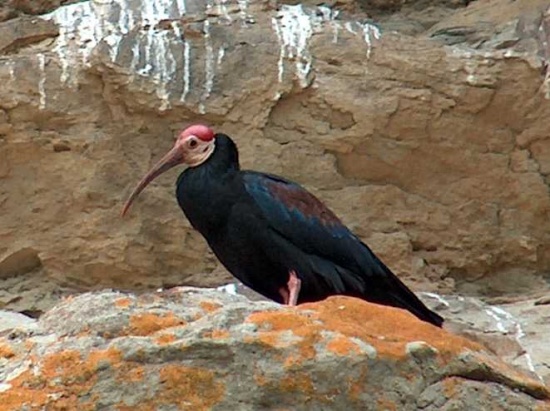m (→Taxonomy) |
|||
| Line 12: | Line 12: | ||
==Habitat== | ==Habitat== | ||
| − | High-altitude (1200- | + | High-altitude (1200-3000 m), moist grassland and cultivated fields with crop residues. Breeds and roosts in colonies on cliffs. Classified as '''Vulnerable''' in the 2007 IUCN Red List due to habitat loss (BirdLife International, 2007). |
==Behaviour== | ==Behaviour== | ||
Gregarious. Typically roosts in groups of 40-50, and forages in smaller groups. Forages, mainly for insects, while walking. | Gregarious. Typically roosts in groups of 40-50, and forages in smaller groups. Forages, mainly for insects, while walking. | ||
Revision as of 07:14, 8 January 2008
- Geronticus calvus
Southern Bald Ibis
Identification
Bare, bright red crown and white face and throat. Feathering dark green with iridescent green, bronze and violet.
Distribution
Eastern South Africa, Lesotho and western Swaziland.
Taxonomy
Geronticus calvus is monotypic.
There is one other species in this genus; the Northern Bald Ibis (Geronticus eremita) of south-western Asia, north Africa and southern Europe.
Habitat
High-altitude (1200-3000 m), moist grassland and cultivated fields with crop residues. Breeds and roosts in colonies on cliffs. Classified as Vulnerable in the 2007 IUCN Red List due to habitat loss (BirdLife International, 2007).
Behaviour
Gregarious. Typically roosts in groups of 40-50, and forages in smaller groups. Forages, mainly for insects, while walking.
References
BirdLife International (2007) Species factsheet: Geronticus calvus. Downloaded from http://www.birdlife.org on 13/11/2007.
Hockey PAR, Dean WRJ & Ryan PG (eds) 2005. Robert's Birds of Southern Africa, 7th edition. Cape Town: John Voelcker Bird Book Fund. ISBN 0620340533




